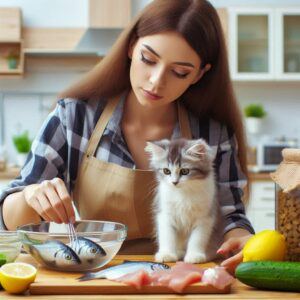Nutritious, Simple Meals Your Feline Will Love
Cats aren’t just small dogs with attitude—they have their own set of dietary requirements that make them unique. It’s crucial to know what makes your feline friend tick when it comes to food. They need a diet rich in proteins and fats, and unlike us humans, they don’t need much in the way of carbs. Think of them as tiny carnivores.

Commercial cat food does its best to hit those nutritional targets, but sometimes, you want to do more. Making cat food at home lets you tweak their diet to suit their needs perfectly, especially if they have any allergies or sensitivities. You gain the control over what’s in their bowl, which is super handy if your cat’s got certain food intolerances.
Now, let’s chat about proteins, fats, and a teeny bit about carbs. Cats thrive on a high-protein diet, with meats like chicken, turkey, or fish being superstars in their meals. Alongside protein, essential fatty acids found in fish oils or chicken fat help keep their fur silky and skin smooth. As for carbs, well, they’re just fringe players in this feline food tale.
Homemade recipes are fantastic, but it’s easy to miss out on essential nutrients if you’re not careful. Important vitamins and minerals, like taurine, calcium, and omega-3s, are big deals in cat diets. Without these, you could be facing nutritional gaps, leading to health hiccups down the line. It’s a bit like making a cake without flour: it just doesn’t end well.
So how do you avoid these potential pitfalls? Research is your best buddy here. Speaking with your vet can provide insights into exactly what your cat might be lacking. There are even supplements designed specifically for cats on homemade diets, helping you fill in those nutritional blanks without batting an eye.
Benefits of Homemade Cat Food
Switching to a homemade diet can be a bit of a game changer for your cat’s health. When you make cat food at home, you’re not just filling their belly, you’re giving them tailored nutrition that can help them thrive.
- One of the standout reasons pet parents opt for the homemade route is for the control over ingredients. Some kitties have sensitive stomachs or allergies and knowing exactly what’s in their meal helps mitigate those sneaky reactions. You can dodge common allergenic ingredients found in store-bought food and choose fresher, high-quality options instead.
- Speaking of quality, you might find that shaking up your cat’s meals doesn’t have to shake up your budget. By buying in bulk and utilizing seasonal produce, homemade cat food could potentially save you a few bucks compared to premium commercial brands. It’s all about finding that balance between cost and quality.
- I’ve seen several cases where cats on a homemade diet not only sidestep allergens but also enjoy improved overall health. Regular reports have shown better coat condition, more consistent energy levels, and even a decrease in common feline ailments. When you see that purrfection on your cat’s whiskered face, it really does feel rewarding.
Lastly, there’s just something really satisfying about preparing a meal from scratch, knowing that every ingredient has been handpicked for your fur buddy. With so many benefits on the line, the extra bit of kitchen time certainly feels like a worthwhile investment.
Top Easy Recipes for Homemade Cat Food
- Crafting your own cat meals can be both easy and rewarding. Ready for some simple recipes that your cat will just paw over? Let’s start with a classic—Chicken Delight. Begin with cooked chicken breast shredded into bite-sized pieces, add a bit of rice for texture, and mix in fish oil for that shiny, healthy coat. Remember, it’s a protein-packed delight that keeps them pouncing all day long.
- Fish Feast is another crowd-pleaser, especially if your cat is fond of seafood. Use fresh tuna or salmon, cooked and shredded. Combine this with a sprinkle of parsley (yeah, cats like herbs too!) and a bit of cooked carrot. This combo not only adds fiber but makes for a delicious, balanced meal that’s simple to whip up.
- Ever thought about a little vegetarian twist? Given sparingly, plant-based meals like Sweet Potato Medley can be a treat. Bake or steam some sweet potatoes, mix in cooked peas, and top it off with a small amount of cottage cheese. While vegetarian is not for everyday, it’s an excellent occasional addition to their meaty menu.
- For those who like variety, Balanced Treats can provide a little something special. Think about mixing cooked turkey with pumpkin puree and a few spinach leaves. This treat offers whole grains and fresh veggies that keep nutrition on point without sacrificing flavor.
These recipes are not just easy to make but allow you to play around with portions and combinations. Keep your vet in the loop about any dietary changes and give these dishes a go to see which ones keep your cat’s whiskers wiggling!
Preparing and Storing Homemade Cat Food Safely
Keeping your homemade cat food safe is just as important as making it tasty. Hygiene should be at the forefront when preparing meals for your feline friend. Start by ensuring your kitchen is spotless and your hands are clean. It’s amazing what a bit of extra care here can do.
Once you’ve nailed the preparation, move onto storage. Proper storage not only keeps the food fresh but also safe for consumption. Airtight containers are your best pals here, helping to maintain the meal’s nutritional value and flavors.
- Freezing portions can be a lifesaver, especially if you’re prepping food in bulk. Just make sure to thaw meals adequately, either in the fridge overnight or for a few hours at room temperature. Remember, microwaving isn’t always a friend to your cat’s palate or nutritional needs.
- Portion control can feel like a juggling act. Overfeeding might seem like an act of love, but it can lead to weight and health issues. Keep an eye on how much you’re serving, making sure it aligns with your cat’s size, age, and activity level.
- Getting all this right might seem like a lot, but once you get the hang of it, food prep and storage become second nature. Your cat depends on you for their health and well-being, and every careful step counts!
Monitoring Your Cat’s Health on a Homemade Diet
After switching to a homemade diet, keeping a close eye on your cat’s well-being is like the final piece of the puzzle. Look out for signs that your furry companion is thriving—shiny coat, bright eyes, and energetic playtime antics are all great indicators that the diet is working wonders.
 Regular check-ins with your vet are vital, especially if you’re switching diets. Keep them up to date with any changes, and don’t hesitate to ask questions. A professional’s insight can make a world of difference, ensuring your homemade meals are a hit and not a miss.
Regular check-ins with your vet are vital, especially if you’re switching diets. Keep them up to date with any changes, and don’t hesitate to ask questions. A professional’s insight can make a world of difference, ensuring your homemade meals are a hit and not a miss.
It’s key to track your cat’s weight and energy levels. Fluctuations in either, can signal dietary adjustments might be needed. Sometimes, it’s just a matter of tweaking portions or ingredients to better suit their needs.
Documenting any noticeable health improvements can also be incredibly rewarding. Jot down those moments of enhanced energy or when you notice a healthier coat. Sharing these milestones, perhaps even with fellow cat lovers or your vet, can motivate you and others on similar journeys.
Switching to homemade meals is a journey itself, and with care and attention, it can lead to a healthier, happier kitty. Every purr, leap, and playful paw is proof that you’re doing something right!
If you have any questions, personal experiences or tips to share, I’d love your feedback. Please make comments below. Thanks for joining me on this journey regarding easy homemade cat food recipes.
